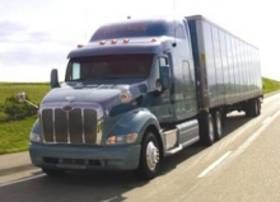Tandems Getting Stuck
Topic 28474 | Page 1
You are going to need to be on asphalt or concrete, level ground, and dry pavement.
Some trailers are a real pain to get to slide, as you've encountered. The heavier the load, the more difficult to slide the tandems.
Spray the pins and the rails with PB Blaster or an equivalent. WD-40 is not thick enough.
Engage the trailer brakes and try moving forward in the lowest gear. Have your window down and listen to the trailer. You can hear the pins unlock. Once this happens, shift to reverse, and adjust as needed. This may take several attempts. If the pins still do not retract, you may need to pound on them with a hammer.
If the trailer tires are just locked, but sliding across the pavement, you may need to utilize chocks. You can also use the curb at a customer or truck stops. I would suggest acquiring at least one check to keep with you. I have mine strapped behind the sleeper, next to the aerodynamic fairings.
Another trick is to reverse the airlines attaching to the trailer: Red on Blue, and Blue on Red. This provides better air to lock the trailer brakes. Just don't forget to switch these back before you attempt to drive away.
Another thing I've done is to do a Figure 8 maneuver around the parking lot with the trailer a few times. This has seemed to un-bind the rail-to-tandems area.
Lastly, and very safely, try reversing at maybe 10 mph, then pull the trailer brakes knob. You'll need a good, deserted parking lot for this one.
Tandems:
Tandem Axles
A set of axles spaced close together, legally defined as more than 40 and less than 96 inches apart by the USDOT. Drivers tend to refer to the tandem axles on their trailer as just "tandems". You might hear a driver say, "I'm 400 pounds overweight on my tandems", referring to his trailer tandems, not his tractor tandems. Tractor tandems are generally just referred to as "drives" which is short for "drive axles".
Tandem:
Tandem Axles
A set of axles spaced close together, legally defined as more than 40 and less than 96 inches apart by the USDOT. Drivers tend to refer to the tandem axles on their trailer as just "tandems". You might hear a driver say, "I'm 400 pounds overweight on my tandems", referring to his trailer tandems, not his tractor tandems. Tractor tandems are generally just referred to as "drives" which is short for "drive axles".

All those are good things to do. I have a couple other tricks, leave both your air knobs in and use the air lever if equipped for setting trailer brakes, it gets you a little more braking power than the parking brakes on some trailers and if really bothersome I have tried finding an incline so you can be sliding the trailer downhill a bit but you need to be careful where you are doing that, I have used an onramp with paved sides before. Another thing is when sliding the tandems all the way back if you remember slide them back forward a few inches as I think they sometimes like to bind when back against the stops.
Tandems:
Tandem Axles
A set of axles spaced close together, legally defined as more than 40 and less than 96 inches apart by the USDOT. Drivers tend to refer to the tandem axles on their trailer as just "tandems". You might hear a driver say, "I'm 400 pounds overweight on my tandems", referring to his trailer tandems, not his tractor tandems. Tractor tandems are generally just referred to as "drives" which is short for "drive axles".
Tandem:
Tandem Axles
A set of axles spaced close together, legally defined as more than 40 and less than 96 inches apart by the USDOT. Drivers tend to refer to the tandem axles on their trailer as just "tandems". You might hear a driver say, "I'm 400 pounds overweight on my tandems", referring to his trailer tandems, not his tractor tandems. Tractor tandems are generally just referred to as "drives" which is short for "drive axles".
HOS:
Hours Of Service
HOS refers to the logbook hours of service regulations.New Reply:
New! Check out our help videos for a better understanding of our forum features

















Preview:








 TT On Facebook
TT On Facebook
I have been experiencing my tandems being stuck when the trailer is fully loaded and at Max weight. You know you can't drive the semi with the trailer tandems all the way back when the trailer is loaded like that so if anyone has any suggestions on how to get your tandems to move forward without too many problems I could appreciate it
Tandems:
Tandem Axles
A set of axles spaced close together, legally defined as more than 40 and less than 96 inches apart by the USDOT. Drivers tend to refer to the tandem axles on their trailer as just "tandems". You might hear a driver say, "I'm 400 pounds overweight on my tandems", referring to his trailer tandems, not his tractor tandems. Tractor tandems are generally just referred to as "drives" which is short for "drive axles".
Tandem:
Tandem Axles
A set of axles spaced close together, legally defined as more than 40 and less than 96 inches apart by the USDOT. Drivers tend to refer to the tandem axles on their trailer as just "tandems". You might hear a driver say, "I'm 400 pounds overweight on my tandems", referring to his trailer tandems, not his tractor tandems. Tractor tandems are generally just referred to as "drives" which is short for "drive axles".